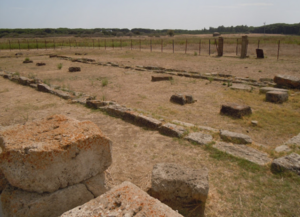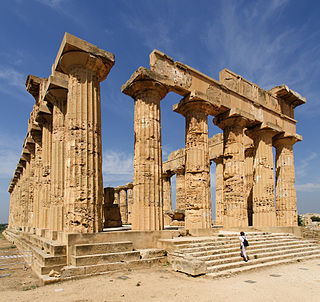
Selinunte was a rich and extensive ancient Greek city of Magna Graecia on the south-western coast of Sicily in Italy. It was situated between the valleys of the Cottone and Modione rivers. It now lies in the comune of Castelvetrano, between the frazioni of Triscina di Selinunte in the west and Marinella di Selinunte in the east.

Magna Graecia was the name given by the Romans to the Greek-speaking coastal areas of Southern Italy in the present-day Italian regions of Calabria, Apulia, Basilicata, Campania and Sicily; these regions were extensively populated by Greek settlers. These settlers, who began arriving in the 8th century BC, brought with them their Hellenic civilization, which left a lasting imprint on Italy. They also influenced the native peoples, such as the Sicels and the Oenotrians, who became hellenised after they adopted the Greek culture as their own. The Greek colonists of Magna Graecia developed a civilisation of the highest level, which had peculiar characteristics, due to the distance from the motherland and the influence of the indigenous peoples of southern Italy.
Year 460 BC was a year of the pre-Julian Roman calendar. At the time, it was known as the Year of the Consulship of Poplicola and Sabinus. The denomination 460 BC for this year has been used since the early medieval period, when the Anno Domini calendar era became the prevalent method in Europe for naming years.

The Charioteer of Delphi, also known as Heniokhos, is a statue surviving from Ancient Greece, and an example of ancient bronze sculpture. The life-size (1.8m) statue of a chariot driver was found in 1896 at the Sanctuary of Apollo in Delphi. It is now in the Delphi Archaeological Museum.
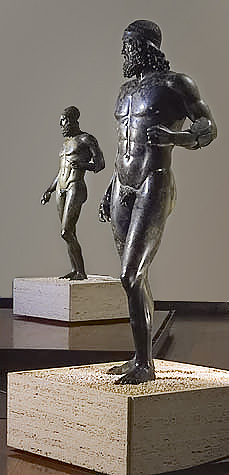
The Riace bronzes, also called the Riace Warriors, are two full-size Greek bronze statues of naked bearded warriors, cast about 460–450 BC that were found in the sea in 1972 near Riace, Calabria, in southern Italy. The bronzes are now in the Museo Nazionale della Magna Grecia in the nearby city of Reggio Calabria. They are two of the few surviving full-size ancient Greek bronzes, and as such demonstrate the superb technical craftsmanship and exquisite artistic features that were achieved at this time.

Paestum was a major ancient Greek city on the coast of the Tyrrhenian Sea in Magna Graecia. The ruins of Paestum are famous for their three ancient Greek temples in the Doric order dating from about 550 to 450 BC that are in an excellent state of preservation. The city walls and amphitheatre are largely intact, and the bottom of the walls of many other structures remain, as well as paved roads. The site is open to the public, and there is a modern national museum within it, which also contains the finds from the associated Greek site of Foce del Sele.

The sculpture of ancient Greece is the main surviving type of fine ancient Greek art as, with the exception of painted ancient Greek pottery, almost no ancient Greek painting survives. Modern scholarship identifies three major stages in monumental sculpture in bronze and stone: the Archaic, Classical (480–323) and Hellenistic. At all periods there were great numbers of Greek terracotta figurines and small sculptures in metal and other materials.
Damophon was an ancient Greek sculptor of the Hellenistic period from Messene, known for his many acroliths found in Messene, Megalopolis, Aegium, Lycosura and other cities of Peloponnesus. Other cities beyond the Peloponnese that Damophon was admired include: the Leucas, Cephallenia, Kynthos, Melos and Oiantheia.

The Apollo of Veii is a life-size painted terracotta Etruscan statue of Aplu (Apollo), designed to be placed at the highest part of a temple. The statue was discovered in the Portonaccio sanctuary of ancient Veii, Latium, in what is now central Italy, and dates from c. 510 - 500 BC. It was created in the so-called "international" Ionic or late-archaic Etruscan style.
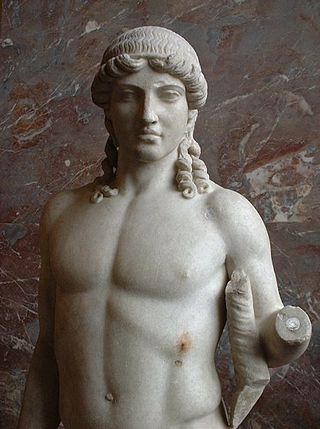
The Apollo of Mantua and its variants are early forms of the Apollo Citharoedus statue type, in which the god holds the cithara in his left arm. The type-piece, the first example discovered, is named for its location at Mantua; the type is represented by neo-Attic Imperial Roman copies of the late 1st or early 2nd century, modelled upon a supposed Greek bronze original made in the second quarter of the 5th century BCE, in a style similar to works of Polyclitus but more archaic. The Apollo held the cythara against his extended left arm, of which in the Louvre example (illustration) a fragment of one twisting scrolling horn upright remains against his biceps.

The Museo Nazionale della Magna Grecia, Museo Archeologico Nazionale di Reggio Calabria or Palazzo Piacentini is a museum in Reggio Calabria, southern Italy, housing an archaeological collection from sites in Magna Graecia.

Paolo Orsi was an Italian archaeologist and classicist.

The Temple of Apollo is one of the most important ancient Greek monuments of Magna Graecia on Ortygia, in front of the Piazza Pancali in Syracuse, Sicily, Italy.

The Heraion at Foce del Sele is an archaeological site consisting of an Ancient Greek sanctuary complex dedicated to the goddess Hera in what was Magna Graecia. When built, the complex was located at the mouth of the Sele, approximately 8 km (5.0 mi) north of the Greek city of Poseidonia that was famous for its three standing Greek temples. Due to the deposition of alluvial sediment by the river, the site now is approximately 2.3 km (1.4 mi) from the modern coast.

The Tavole Palatine are the remains of a hexastyle peripteral Greek temple of Magna Graecia the 6th century BC, dedicated to the goddess Hera and the god Apollo. The temple, located near the Bradano river in the south of Italy, was part of a countryside sanctuary and remains of the wall of the temenos and of a very ancient altar are visible.
Several Hellenistic kings dedicated monuments in the sanctuary of Apollo in Delphi, in an effort to emphasize their prestige. Among those kings were the Attalids of Pergamon, who occupied a prominent position at the highest point of the Sacred Way, close to the temple of Apollo where they erected their ex votos.

The Temple of Juno Lacinia is a ruined ancient Greek temple and sanctuary dedicated to Hera located on Capo Colonna in Calabria, Italy, near Crotone. The main remaining feature is a Doric column with capital, about 27 feet (8.2 m) in height.
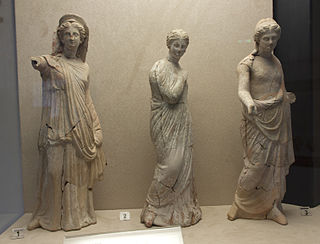
The Archaeological Museum of Aidone is a regional museum in Aidone in the province of Enna, Sicily. It is housed in a former Capuchin convent dedicated to Saint Francis. It was inaugurated in the summer of 1984 and preserves the findings of over thirty years of excavations in Morgantina, ordered according to chronological and thematic criteria.
